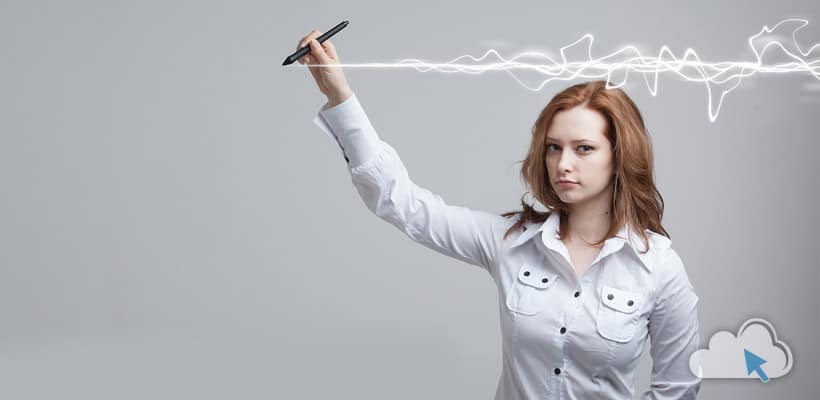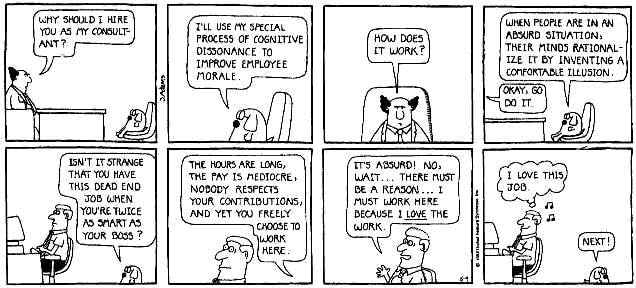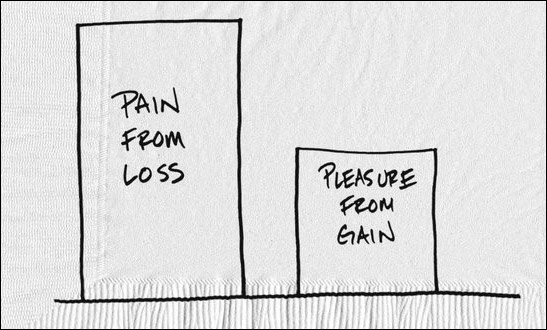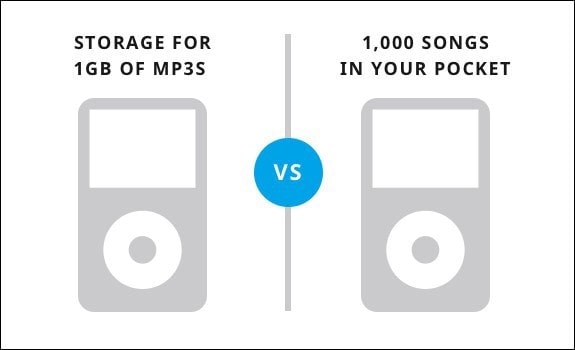Contrary to popular belief, copywriting doesn’t simply involve putting up a few haphazard paragraphs on your website and hoping for the best.
There’s a whole lot more to it than that.
Think about the sheer amount of content that’s already out there. In order to stand out and get people to take action, you have to tap into core beliefs and human behavior. Which is where psychology comes in.
Psychology and copywriting are so entwined.
Combining solid writing with persuasive psychological triggers creates a match made in heaven that will win you more sales. Let’s take a look at some of the most successful psychological triggers you can implement.
1. The Novelty Factor
Think about Apple for a moment. That huge corporation. They release a new model every single year, despite the differences to the old ones being miniscule. Yet, time and time again, people queue up for hours to get their hands on the latest style.
Why? According to neurological studies, being exposed to something new and novel increases how much dopamine is released into our brain.
 Apple does a great job of creating the novelty factor – getting customers to want their latest & greatest products.
Apple does a great job of creating the novelty factor – getting customers to want their latest & greatest products.
How to Use the Novelty Factor:
Add new features to your products every few months to keep them fresh and desirable. Even if it’s just a few tweaks here and there, make sure you promote them and add them to your product descriptions.
2. Use Social Proof
According to the Yale attitude change model, customers are more likely to change their minds in response to your advertising message if there is credibility that correlates with it. One aspect of credibility is what others are saying about your message. The basic idea of this is that it is “who said what to whom”. For example, using testimonial messages from other customers helps to reinforce your message with new customers.
How to use use social proof:
Add positive customer testimonials, online reviews, and other forms of social proof that reinforce your message. For example, simply showing your potential customers that other customers have just signed up or made a purchase on your website is a very powerful form of social proof. UseProof.com, allows you to do this by placing a simple popup on the customer’s screen, letting them know that others like themselves are using this service.
 UseProof.com is a powerful service that reinforces social proof and is known to increase sales by average of 10%.
UseProof.com is a powerful service that reinforces social proof and is known to increase sales by average of 10%.
3. Reciprocity
We’re more likely to do something for someone who’s nice to us. It makes sense, right? Dr. Robert Cialdini backed this up in a study that showed subjects rated others as more likable if those people had bought them a can of soda. Simple, but effective. The idea of reciprocity in copywriting means that people will be more likely to buy from you if you do something for them first.
How to Use Reciprocity:
You don’t even have to go out of your way to do something special for every potential customer. In fact, sites like Copyblogger simply offer an abundance of amazing free content before asking readers to sign up for $1 a month as a subscriber.
The fact that the reader has received tons of helpful tips and value already means they’re more likely to pay for more.
4. Sell Something Smaller
Big purchases take time to consider. Instead of diving right in and shoving a high-priced product in your audiences’ face, start with a smaller, cheaper product that will give them an idea of the value you can give them and what they can expect to get from you with a higher-priced product.
Think of it like you’re easing them into a bigger sale. For the most part, customers will continue to buy products from brands they already know and have bought from.
How to Sell Something Smaller:
Offer a smaller, leaner version of your product or service as a kind of “taster” to get people interested. Alternatively, create a set of lower-tier products that lead into your higher-priced offering.
5. The Snob Effect
People like to feel special. Fact. The so-called Snob Effect ties into this idea by offering limited editions and special extras for people who buy first or for loyal customers.
As humans, we like to feel part of a group or a community, and the more exclusive that community, the better, right?
How to Use the Snob Effect:
Add limited edition products to your line or give loyal customers a little something extra when they buy to make them feel special.
6. The Conformity Phenomenon
The conformity phenomenon is a great example of social proof. Basically, it’s where you hint to a potential customer that their peers, friends, and family have all invested in your product and they’ll feel left out if they don’t, too.
We hate feeling left out. We want to be a part of the action, hence why adding in a sense of conformity works so well.
How to Use the Conformity Phenomenon:
Share how many other customers similar to your reader have bought your product. A simple sentence like “40% of your fellow marketers use X product, will you be joining them?” works wonders.
7. Cognitive Dissonance
Cognitive dissonance refers to the psychological tension that arises when someone makes a decision that doesn’t fully align with the beliefs or lifestyle. For example, when someone buys a high-priced product and lies awake thinking about how much they’ve spent – that’s cognitive dissonance.
How to Use Cognitive Dissonance:
You’re more likely to put this into play after someone has bought from you. When a customer has purchased a high-priced product, you can soothe their worries with testimonials and successful case studies.
8. Loss Aversion
According to research, we feel loss more than we feel gain. For example, if we were told we were going to get a raise of $2,000, we’d be happy, but if we were told we were going to get our salary cut by $2,000, we’d be livid, sad, and frustrated. The emotions we’d feel at losing that money rather than gaining it would far outweigh the happiness we’d feel at gaining it. This is the power of loss aversion. When faced with losing something, we tend to act quicker and on impulse.
How to Use Loss Aversion:
You want to create a situation where your audience thinks they’re going to lose something if they don’t buy your product. You can use language to show the consumer already has the product, a video showing someone else using the product, or simply offer a trial for a limited period of time.
9. Exposure Theory
This refers to the idea that the more we are exposed to something the more likely we are to buy it. According to some research, it takes seven touches for a consumer to make a purchase, so as a business, you need to provide those seven touch points.
I mean, how are we supposed to want to buy something if we don’t know it exists?
How to Use Exposure Theory:
Make sure there are multiple points on your site where your consumers can see and learn about your product. It’s not enough to just have the information on one page. Instead, you want to spread it around in the sidebars, footers, homepage, social media, and beyond.
10. The Decoy Effect
Ever gone to buy something online and seen a selection of pricing tiers? This is called the decoy effect, and it’s where three options are given, two of which are at the same higher price but one offers additional extras. The decoy effect can also be taken further by highlighting the option you want consumers to take.
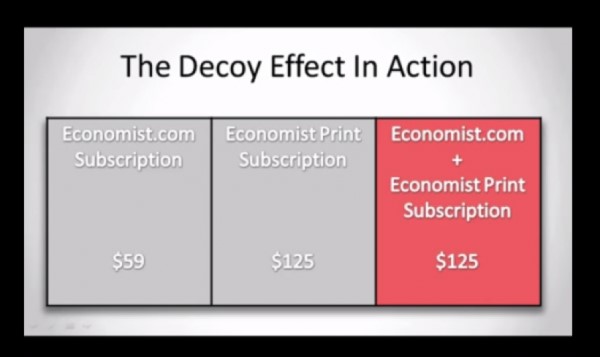 The Economist is a great example of this.
The Economist is a great example of this.
How to Use the Decoy Effect:
Present your product in three different pricing tiers, where the two higher-price points are the same but one offers additional extras.
11. Context Effect
How often do you buy popcorn when you’re out shopping? Now think about how often you buy popcorn when you’re at the cinema. I’m willing to bet you are considerably more likely to buy popcorn at the cinema, because that’s what you are supposed to do at the cinema. This is the context effect.
How to Use the Context Effect:
Create a setting for your consumers that makes them want to buy or at least find themselves in the mindset for buying. Research shows that the comfort level of the floor, for example, impacts how consumers assess the quality of the product their buying. Taking this online, you can create a pleasant experience for consumers to want to buy in.
12. $100 Versus $98
You’ve probably seen it in the shops when products are priced at $9.99 rather than a flat rate of $10.00. Why is this? It’s because subconsciously we think we’re saving money with the $9.99 price tag. Sounds silly, but it works.
How to Use the $100 vs $98 Theory:
For any products you have priced at a flat rate with a zero on the end, switch it up so that the price ends in an 8, 7, or 9 to give that sense of saving money.
13. Sense of Urgency
We don’t like to feel as if we’ve missed out on something, which is why urgency is an important psychological trigger in copywriting. It’s essentially when brands offer a product for a short time only, or offer it at a lower price point for the first 20, 50, or 100 buyers.
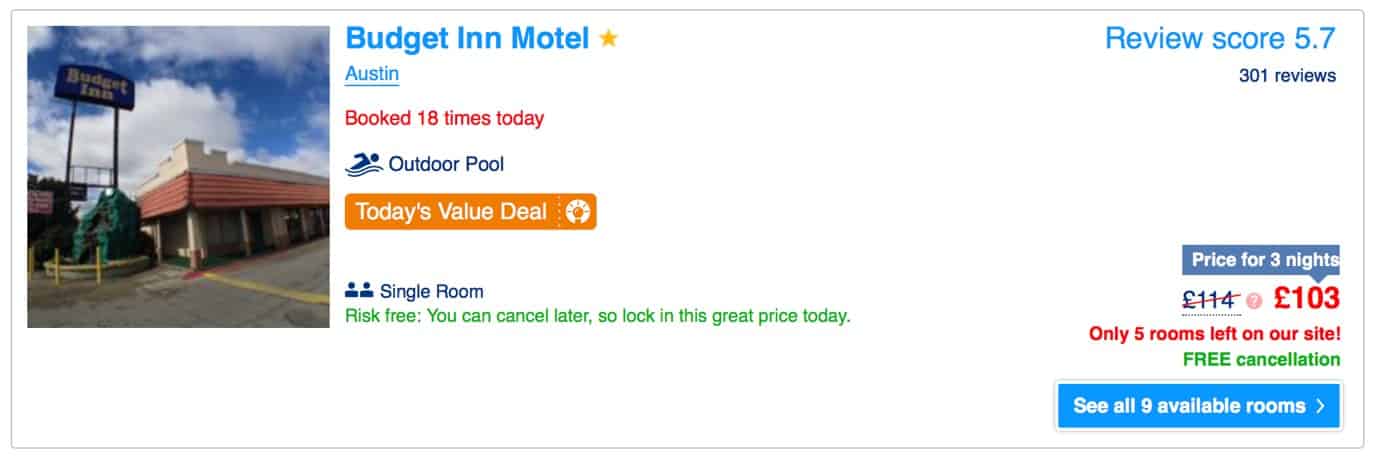 Budget Inn Motel does a great job of creating a sense of urgency in this add with “Only 5 rooms left on our site!”
Budget Inn Motel does a great job of creating a sense of urgency in this add with “Only 5 rooms left on our site!”
How to Create a Sense of Urgency:
Hold a flash sale on your product, or offer it for a discount to a few select people who buy first. Alternatively, you can advertise only having a few left – just like plenty of accommodation and flight providers do to get hesitant buyers to hit purchase.
14. Sell Benefits Not Features
Benefits sell, not features. You might think sharing all the shiny features your product has will entice buyers, but they don’t care what bells and whistles your product has. Instead, they care about how your product can help them solve their problems and reach their goals.
How to Sell Benefits Not Features:
Every time you think of a feature of your product, consider how that will help potential buyers reach their goals. Change the copy on your website to reflect this, so it’s all about them rather than your product.
15. Storytelling
Humans love stories. We connect to them like no other writing format. Studies show that reading stories create a complex physiological reaction in our brains, activating all our neurological senses. This helps us think, feel, see, and even smell what it would be like to have a product – a powerful concept.
How to Use Storytelling:
All stories have a beginning, a middle, and an end. Tie this into your sales copywriting by outlining what your potential buyer’s life is like before they have their product, what the product will do for them, and what their life will look like after they’ve purchased it.
16. Agitate Pain Points
The problem, agitate, solve theory is huge in the sales copywriting world. It basically refers to the idea that you lay out a key problem your audience have, then agitate that problem so they’re ready to do something about it, and then solve it by introducing your product as the answer.
How to Agitate Pain Points:
Pick out a core problem your audience has and tap into that. Outline what their lives are like with that problem and agitate it by telling them why it’s their fault they have that problem. Then, quickly introduce your product as the holy grail to that problem.
17. Build a Community
As I mentioned earlier, people love to feel like they’re part of something. Let’s refer back to Apple again, who have created this incredible group of raving fans who buy anything and everything they offer. The act of creating a community around your brand and product is incredibly powerful if done right.
How to Build a Community:
Open a dialogue with your audience, speak directly to them, and share stories about other customers that they can relate to. In order to feel like part of the community, they have to feel like they “fit in”, so use language they’d use and outline situations they might find themselves in.
18. Provide Less Options
A lot of businesses think that if they have more options, they’ll appeal to more people and will therefore make more sales. In fact, the opposite happens. Because we’re humans, we suffer with severe overwhelm when presented with too many options. This leads us to freeze up and not buy anything.
How to Provide Less Options:
Whittle down your product offerings to a few key options and outline exactly what each option will get the buyer. Try to differentiate between them as best as you can and sack off any options that appear too similar.
19. Create Curiosity
Humans are curious creatures. Think about those click-bait headlines that go viral. The ones like “This Man Cooked Dinner… You’ll Never Guess What Happened Next”. Even if we don’t care, there’s an innate need to find out what happened next. Creating curiosity is a powerful way to draw people in and get them to buy.
How to Create Curiosity:
First of all, you want to find out where that information gap is – you know, the gap between what they do know and what they don’t. Then, you want to churn up their expectations. You might do this by stating specific facts and figures, like “How to Get 50% More Sales in a Day”.
20. Tap into Emotions
According to research, people make decisions with their emotions, not their logical brains. If on an emotional level they want something, they’ll find a way to get it. When you’re presenting products for sale, you want to encourage people to get emotional in order to get them to click buy.
How to Tap into Emotions:
Heighten emotions by sharing happy stories or generate a sense of anger and frustration by agitating those key pain points. Language is a great way to get people to feel things, so use words like “amazing” instead of “good”.
Conclusion
As you can see, applying psychological triggers to your copywriting doesn’t have to be difficult.
By simply tapping into core human beliefs and behavior, you’re already putting yourself ahead of the businesses that don’t. Because, though we may not know it, our everyday lives are filled with psychological triggers that dictate our behavior and thought patterns.
THE BEHIND THE SCENES OF THIS BLOG
This article has been written and researched following a precise methodology.
Our methodology